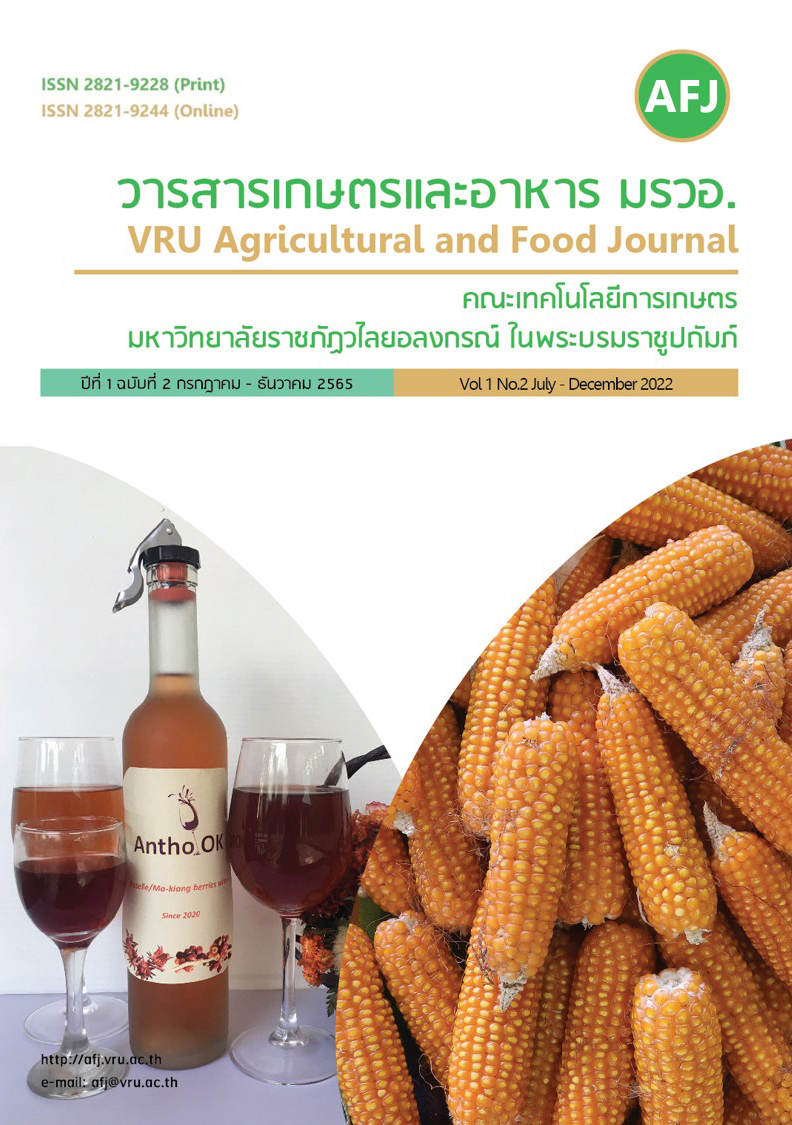แอนโทไซยานินและฤทธิ์การต้านอนุมูลอิสระของไวน์สีชมพูที่ผลิตจากดอกไม้ท้องถิ่นและมะเกี๋ยง
Main Article Content
บทคัดย่อ
แอนโทไซยานินเป็นพฤกษเคมีสำคัญพบในดอกไม้และผลไม้ซึ่งให้สีในไวน์ชมพู งานวิจัยนี้มีวัตถุประสงค์เปรียบเทียบแอนโทไซยานินและฤทธิ์การต้านอนุมูลอิสระของไวน์ชมพูโดยใช้ดอกไม้ท้องถิ่น (ชบาแดง กุหลาบแดง บัวชมพู และกระเจี๊ยบ) แล้วคัดเลือกดอกไม้ที่หมักได้ไวน์ที่มีแอลกอฮอล์สูงสุดคือ กระเจี๊ยบมาผสมมะเกี๋ยงแล้วหมัก จากนั้นเปรียบเทียบยีสต์ 3 สายพันธุ์ (Montrachet, Cote des Blances, และ Premier Cuvee) การหมักดำเนินการที่ 30 องศาเซลเซียส นาน 15 วัน วิเคราะห์แอนโทไซยานิน ฟีนอลิกทั้งหมด ฟลาโวนอยด์ ฤทธิ์การต้านอนุมูลอิสระ (DPPH, ABTS, และ FRAP) และปริมาณของแข็งละลายน้ำได้ทั้งหมด ค่าพีเอช ค่าสี (L*, a* และ b*) และแอลกอฮอล์ พบว่า ไวน์ชมพูหมักโดยใช้ดอกไม้ท้องถิ่นมีปริมาณแอลกอฮอล์ในช่วง 6-12% ปริมาณของแข็งที่ละลายน้ำได้ทั้งหมด 7.7-14.2 oBrix และค่าพีเอช 2.70-3.19 แอนโทไซยานินในไวน์เรียงตามลำดับจากมากไปน้อยคือ ชบา กระเจี๊ยบ บัวชมพู และกุหลาบแดง ไวน์ชบามีฤทธิ์การต้านอนุมูลอิสระสูงที่สุด การเปรียบเทียบสายพันธุ์ยีสต์ในการหมักไวน์กระเจี๊ยบผสมมะเกี๋ยง ปริมาณแอลกอฮอล์ในช่วง 5-9% ปริมาณของแข็งที่ละลายน้ำได้ทั้งหมด 8.4-12.0 oBrix และค่าพีเอช 2.90-3.03 ไวน์กระเจี๊ยบผสมมะเกี๋ยงหมักด้วยยีสต์ สายพันธุ์ Premier Cuvee มีแอนโทไซยานิน ฟีนอลิกทั้งหมด ฟลาโวนอยด์ และฤทธิ์การต้านอนุมูลอิสระมากกว่ายีสต์สองสายพันธุ์ คือ Montrachet และ Cote des Blances
Article Details

อนุญาตภายใต้เงื่อนไข Creative Commons Attribution-NonCommercial-NoDerivatives 4.0 International License.
บทความนี้ได้รับการเผยแพร่ภายใต้สัญญาอนุญาต Creative Commons Attribution-NonCommercial-NoDerivatives 4.0 International (CC BY-NC-ND 4.0) ซึ่งอนุญาตให้ผู้อื่นสามารถแชร์บทความได้โดยให้เครดิตผู้เขียนและห้ามนำไปใช้เพื่อการค้าหรือดัดแปลง หากต้องการใช้งานซ้ำในลักษณะอื่น ๆ หรือการเผยแพร่ซ้ำ จำเป็นต้องได้รับอนุญาตจากวารสารเอกสารอ้างอิง
Chaiyasut, C., Siramurathi, B. S., Pengkumsri, N., Sirilun, S., Peerajan, S., Chaiyasut, K. and Kesika, P. 2016. Anthocyanin profile and its antioxidant activity of widely used fruits, vegetables, and flowers in Thailand. Asian J. Pharm. Clin. Res., 9(6): 218-224.
Darwish, R. M. and Aburjai, T. A. 2011. Antimicrobial activity of some medicinal plants against different Candida species. Jordan J. Pharm Sci., 4(1): 70-80.
Du, B., He, B., Shi, P., Li, F., Li, J. and Zhu, F. 2012. Phenolic content and antioxidant activity of wine grapes and table grapes. J. Med. Plant Res., 6(17): 3381-3387.
Echevevrrigaray, S., Scariot, F., J., Menegotto, M. and Delamare, A. P. L. 2020. Anthocyanin adsorption by Saccharomyces cerevisiae during wine fermentation is associated to the loss of yeast cell wall/membrane integrity. Int. J. Food Microbiol., 2:314:108383.
Han, F. Ju, Y., Rusm, X., Zhao, X., Yue, X., Zhuang, X., Qin, M. and Fang, Y. 2017. Color, anthocyanin, and antioxidant characteristics of young wines produced from spine grapes (Vitis davidii Forex) in China. Food Nutri. Res., 61:1, 1339552,
Hisatomi, T. and Toyomura, K. 2021. Isolation, Identification, and characterization of wild yeast budding yeast from rose flowers in Fukuyama city, Hiroshima, Japan, and their application in bread and wine production. Mycoscience., 62Z6X: 382-389.
Loypimai, P. 2012. Total antioxidant capacity assessment in vitro. J. Sci. Technol. MSU. 31(2): 164-170.
Poontawee, W., Natakankitkul, S. and Wongmekiat, O. 2016. Protective effect of Cleistocalyx nervosum var. paniala Fruit extract against oxidative renal damage caused by cadmium. Molecules, 21, 133.
Patthamakanokporn, O. Puwastein, P., Nitithamyong, A. and Sirichakwal, P. P. 2008. Changes of antioxidant activity and total phenolic compounds during storage of selected fruits. J. Food Compos. Anal., 21: 241-248.
Prasanth, M. I. Brimsom, J. M., Chuchawankul, S., Sukprasansap, M. and Tencomnao, T. 2019. Antiaging, stress resistance, and neuroprotective efficacies of Cleistocalyx nervosum var. paniala fruit extracts using Caenorhabditis elegans model. Oxid. Med. Cell longev., ID7024785.
Prasanth, M. I, Sivamaruthi, B. S., Sukprasansap, M., Chuchawankul, S., Tencomnao, T. and Chiyasut, C. 2020. Functional properties and bioactivities of Cleistocalyx nervosum var. paniala berry plant: a review. Food Sci. Technol., 40 (Suppl 2)
Sarima, R. I. A. and Meryandini, A. 2019. Modulation of aging in yeast Saccharomyces cerevisiae by roselle petal extract (Hibiscus sabdariffa L.). Am. J. Biochem. Biotech., 15(1):23.32
Sirikhansaeng, P., Saenkhol, N. and Chumsena, L. 2020. The study of chemical properties and sensory test of roselle wine and roselle mix mulberry wine. RMUTTO R. J., 13(1): 111-119.
Srivanthana, B., Treesangsri, W., Boriboontrakul, B., Niumsakul, S. and Chavalittumrong, P. 2007. In vitro effects of Thai medicinal plants on human lymphocyte activity. Songklanakarin J. Sci. Technol., 29(sppl.1): 17-28.
Thai Industrial Standard Institute. 2003. Thai Community Product Standard, Fruit wine (TCPS 2/2546). Bangkok, Ministry of Industry.
Thai Industrial Standard Institute. 2003. Thai Community Product Standard, Herbal wine (TCPS 31/2546). Bangkok, Ministry of Industry.
Wauters, T., Iserentant, D. and Verachtert, H. 2001. Sensitivity of Saccharomyces cerevisiae to tannic acid is due to iron deprivation. Can. J. Microbiol. 47(4): 290-293.


